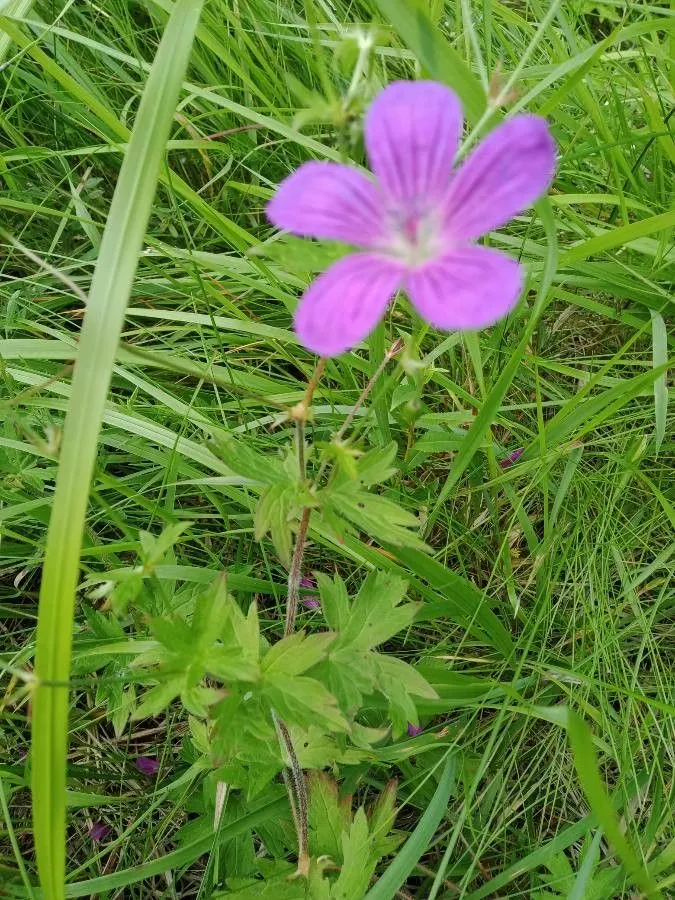
Author: L.
Bibliography: Cent. Pl. II: 25 (1756)
Year: 1756
Status: accepted
Rank: species
Genus: Geranium
Vegetable: False
Observations: Europe to SW. Siberia and Caucasus
Marsh cranesbill, known scientifically as Geranium palustre, is a captivating plant species belonging to the Geraniaceae family. Commonly found across Europe and extending its reach into Southwestern Siberia and the Caucasus region, this plant has managed to capture the interest and admiration of botanists and plant enthusiasts alike.
The species Geranium palustre was first described and classified by renowned botanist Carl Linnaeus in his publication “Cent. Pl. II: 25,” which came out in 1756. Since then, the plant has been extensively studied and appreciated for both its aesthetic value and ecological significance.
Marsh cranesbill typically thrives in wetland areas, making its home in marshes, damp meadows, and along the edges of streams and rivers. It is well-adapted to these moist environments, where it can often be seen producing its charming flowers from late spring to early autumn. The flowers of Geranium palustre are distinguished by their vibrant pink to purplish hues, which serve as an attractive feature in the natural landscapes they adorn.
This perennial herb can reach a height of 30-60 cm and is noticeable for its deeply lobed leaves, which add to its overall delicate yet lush appearance. The foliage not only provides an appealing contrast to the bright blossoms but also plays a crucial role in supporting the ecological balance of its habitat by offering shelter and food to a variety of insects and small wildlife.
Over time, Marsh cranesbill has also found its way into cultivated gardens, valued for its ease of growth and the bursts of color it introduces to boggy or waterlogged garden areas. Gardeners appreciate its resilience and minimal maintenance requirements, along with its ability to attract pollinators such as bees and butterflies, thus enriching the biodiversity of garden spaces.
In conclusion, Geranium palustre stands out as a botanical gem in both wild and controlled environments, admired for its striking flowers, ecological contributions, and the subtle historic charm of a species that has been recognized and appreciated for centuries.
Dan: kær-storkenæb
Deu: sumpf-storchschnabel
Swe: kärrnäva, ojakurjenpolvi
Nob: myrstorkenebb
Nno: myrstorkenebb
Fin: ojakurjenpolvi
En: Marsh cranesbill, Marsh crane’s-bill
Be: Герань балотная
Bg: Блатен здравец
Cs: Kakost bahenní
Da: Kær-storkenæb
Nl: Moerasooievaarsbek, Moeras-Ooievaarsbek, Moerasooievaarsbe
Et: Soo-kurereha
Fi: Ojakurjenpolvi
Fr: Géranium des marais
De: Sumpf-Storchschnabel
Hu: Mocsári gólyaorr
It: Geranio palustre
Nb: Myrstorkenebb
Nn: Myrstorkenebb
Os: Гуыбыннизхос
Pl: Bodziszek błotny
Ru: Герань болотная
Sk: Pakost močiarny
Sv: Kärrnäva, Ojakurjenpolvi
Uk: Журавець болотяний
© copyright of the Board of Trustees of the Royal Botanic Gardens, Kew.
© copyright of the Board of Trustees of the Royal Botanic Gardens, Kew.
© copyright of the Board of Trustees of the Royal Botanic Gardens, Kew.
Taken Aug 20, 2022 by Andrzej Konstantynowicz (cc-by-sa)
Taken Aug 20, 2022 by Andrzej Konstantynowicz (cc-by-sa)
Taken Aug 16, 2022 by Andrzej Konstantynowicz (cc-by-sa)
Taken Sep 27, 2018 by Wolfgang Jauch (cc-by-sa)
Taken Sep 15, 2017 by Michel Nialon (cc-by-sa)
Taken Nov 11, 2021 by cscoq (cc-by-sa)
Taken May 5, 2022 by David Hocken (cc-by-sa)
Taken Aug 20, 2020 by Александр Александр (cc-by-sa)
Taken Aug 16, 2022 by Andrzej Konstantynowicz (cc-by-sa)
Taken Sep 27, 2018 by Wolfgang Jauch (cc-by-sa)
Taken Aug 29, 2022 by Irmgard Groß (cc-by-sa)
Taken Aug 2, 2020 by Ondřej Jokerrr83 (cc-by-sa)
Taken Jul 3, 2022 by Алена Подольская (cc-by-sa)
Taken Aug 2, 2020 by Alex Alex (cc-by-sa)
Taken May 5, 2022 by David Hocken (cc-by-sa)
Taken Aug 15, 2007 by Photoflora – Benoit BOCK (©)
Taken Aug 9, 2021 by Werner Rom (cc-by-sa)
Taken Jan 1, 1800 by Tela Botanica − Thierry Pernot (cc-by-sa)
Taken Aug 15, 2007 by Photoflora – Benoit BOCK (©)
Taken Aug 15, 2007 by Photoflora – Benoit BOCK (©)
Taken Aug 22, 2021 by Ornitho Galum (cc-by-sa)
Taken Jul 3, 2022 by Pavel Veselý (cc-by-sa)
Taken Jul 15, 2009 by Photoflora – Benoit BOCK (©)
Taken Jul 15, 2009 by Photoflora – Benoit BOCK (©)
Taken Aug 15, 2007 by Photoflora – Benoit BOCK (©)
Taken Sep 1, 2021 by Mariusz Staniszewski (cc-by-sa)
Taken Sep 27, 2018 by Wolfgang Jauch (cc-by-sa)
Ph maximum: 8.0
Ph minimum: 7.5
Light: 7
Atmospheric humidity: 8
Bloom months: [‘jul’, ‘aug’]
Soil nutriments: 7
Family: Myrtaceae Author: (F.Muell.) K.D.Hill & L.A.S.Johnson Bibliography: Telopea 6: 402 (1995) Year: 1995 Status:…
Family: Rubiaceae Author: Pierre ex A.Froehner Bibliography: Notizbl. Bot. Gart. Berlin-Dahlem 1: 237 (1897) Year:…
Family: Sapindaceae Author: Koidz. Bibliography: J. Coll. Sci. Imp. Univ. Tokyo 32(1): 38 (1911) Year:…
Family: Asteraceae Author: A.Gray Bibliography: Pacif. Railr. Rep.: 107 (1857) Year: 1857 Status: accepted Rank:…
Family: Fabaceae Author: Medik. Bibliography: Vorles. Churpfälz. Phys.-Ökon. Ges. 2: 398 (1787) Year: 1787 Status:…
Family: Aspleniaceae Author: (Cav.) Alston Bibliography: Bull. Misc. Inform. Kew 1932: 309 (1932) Year: 1932…